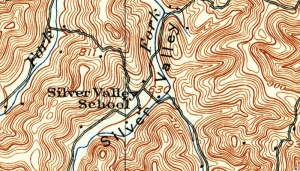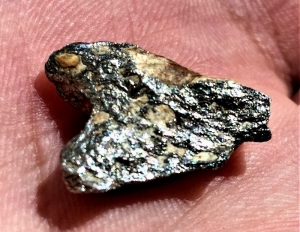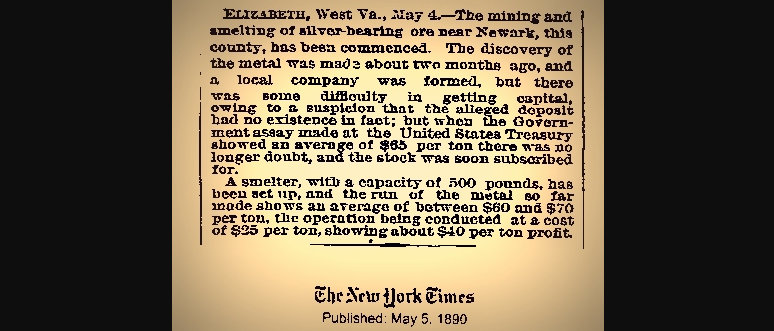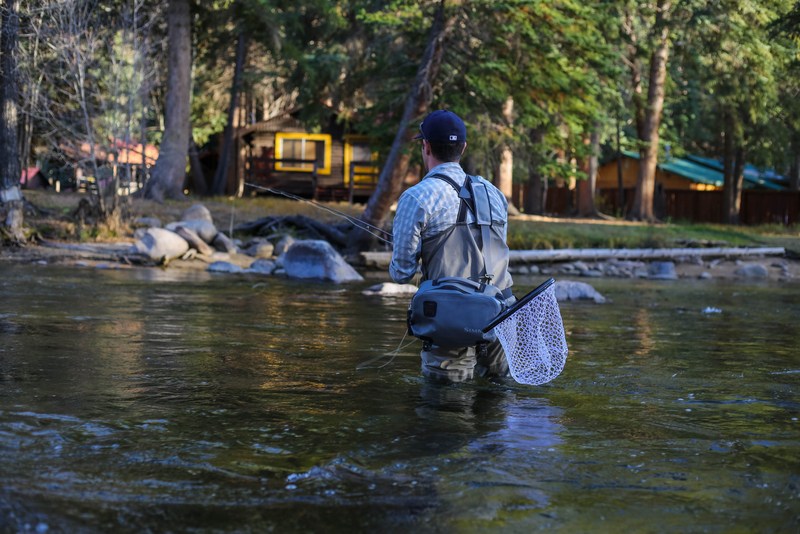SILVER VALLEY, W.Va. — Is there silver in the hills of West Virginia? Parts of what's now western West Virginia enjoyed a kind of silver rush in the late 1800s, and many prospectors opened mines, though geologists say their efforts were for naught.
Geologists seem to agree that strata underlying the valley of the Ohio River do not bear the ores in which silver is found. Despite that, three mining companies held leases in Jackson County in 1867, and another attempted to mine and smelt the precious metal in Wirt County.

The Pomeroy Silver Mining Co., of Meigs County, Ohio, the Pittsburgh Exploring, Developing and Mining Co., of Pittsburgh, and the Point Pleasant Silver Mining and Exploring Co., of Point Pleasant, all leased Jackson County land, according to a report in the West Virginia Heritage Encyclopedia.
The Point Pleasant concern boasted 16 stockholders, among whom was Professor William Eichoff, who was said to have determined that "large quantities of silver and gold" were present.
In 1877, a shaft was sunk 500 feet on the Woodruff Farm on Mill Creek in Union District, and at about the same time, another was sunk 350 feet on the Albert Shinn Farm on Cow Creek. According to the report, the area around the latter is still known as Silver Valley.
Samples of silver ore were provided as evidence, but as no source was ever located, it's been suggested that many of these finds were hoaxes.
Coincidentally, the community of Silverton is located in Jackson County, not far from Silver Valley. However, the late local historian Mike Ruben pointed out that silver was not discovered in that community either, the name being adopted from a surname.
"It's interesting that there's both a Goldtown and a Silverton in Jackson County but that neither gold nor silver has been found here," Ruben said.
The prospectors in Wirt and Jackson counties may have been induced by legends of silver lodes elsewhere in West Virginia. One such tale postulated that Captain Phillip Thurman discovered silver on Cannelton Mountain in northwestern Fayette County. Another held that Field Hudnall found silver in Rich Hollow on Kellys Creek in eastern Kanawha County.
In 1927, J.H. Kidwell, in the fictional book "Silver Fleece," wrote of an Indian who appeared in Alexandria, Va., in the 1760s wearing a silver necklace. The group of would-be prospectors he inspired traveled across western Virginia to Kentucky to discover mines, though, again, the book was fiction.
Another more involved tale concerned a silver mine allegedly operated by the Pence family near Meadow Bridge in southeastern Fayette County. According to the late historian Shirley Donnelly, the Pences discovered a lode and began minting the silver.
"Quick to detect the value of their discovery and use the silver, it was alleged that they started a coinage system of their own. They minted their silver into the fashion of the current coinage of the realm. There was more silver in the coins struck by the Pence people than in the government issue of silver money," Donnelley wrote.
"When the silver-money-making activities of the Pence men were observed by members of the pioneer Gwinn family of that community, they reported the matter to law officials."
Donnelly wrote that he was informed of the matter by Robert Lee McGraw, who told him that the Pences were "sent to the pen" but were not counterfeiters and "were convicted of making money rather than letting the government produce it."
"When they were hailed into court on the charge of making their own silver money, the Pence men, who had found the silver mine, refused to divulge the location of the silver load. They determined to keep its location secret as long as any of the Gwinn family was alive."
Prospectors might have also been inspired by tales of Swift's "lost" silver mine, allegedly discovered in 1760 in eastern Kentucky, southwest Virginia or eastern Tennessee by an Englishman named Jonathan Swift. Some say the mine might have been located in southwestern West Virginia.
According to the legend, Swift explored Kentucky before Daniel Boone and was led by a wounded bear into a cave where he discovered silver. He often returned to the cave to smelt bars and coins and buried part of his treasure nearby. He later walled the cave to prevent its discovery but was stricken blind and could never find it.
Is there silver in West Virginia? According to the West Virginia Geologic Survey, no native silver has been recognized in West Virginia.
Lost silver lode in Jackson County may be more than a legend

Legends of a lost silver lode in Jackson County, in western West Virginia, may be more than a rumor, according to a former resident whose claims are backed up by historical accounts, and he says he has a nugget to prove it. "I've always said that there's something to these legends," says William Byrne Mollohan, who grew up a stone's throw from the Silver Valley, one of several areas in the region where silver was once believed to exist. READ THE FULL STORY HERE.
Sign up to receive a FREE copy of West Virginia Explorer Magazine in your email weekly. Sign me up!


